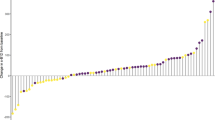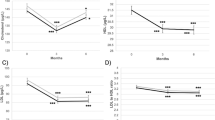Abstract
The effects of an arsenic-rich fish diet and selenium (Se) supplementation on blood arsenic (As), Se, and thyroid hormones were studied in 32 women divided into four equal groups. Groups 1 and 4 received 400 µg Se-methionine daily, group 2 received 400 µg selenite daily, and group 3 received placebo tablets for 15 wk. In addition, groups 1–3 increased their fish intake, eating at least three fish dinners weekly. Mean blood Se concentrations (initially 1.68 ± 0.24 µmol/L) increased twofold in the Se-methionine groups (p < 0.0001) and by 32% in the selenite group (p < 0.01). Group means of blood As concentrations increased by 63% (p < 0.01), 50% (p < 0.01), 106% (p < 0.01), and 29% (p < 0.05) in the four groups, respectively. Analyzed As intake from duplicate portions of consumed fish correlated with final blood As concentrations (r=0.85, p < 0.001, n=32). In the group not receiving Se, there was a positive correlation between final blood As concentrations and plasma T4 : T3 ratio (r=0.80, p < 0.02, n=8). Initially, blood As concentrations correlated negatively with both T3 and T4 in plasma, but this correlation disappeared upon Se supplementation. The results demonstrate that increased intake of fish may influence blood As concentrations and that circulating thyroid hormones may be influenced by Se-As interactions.
Similar content being viewed by others
References
C. O. Abernathy, Y. P. Liu, D. Longfellow, H. V. Aposhian, B. Beck, B. Fowler, et al., Arsenic: health effects, mechanisms of actions, and research issues, Environ. Health Perspect. 107, 593–597 (1999).
F. Queirolo, S. Stegen, M. Restovic, M. Paz, P. Ostapczuk, M. J. Schwuger, et al., Total arsenic, lead, and cadmium levels in vegetables cultivated at the Andean villages of northern Chile, Sci. Total Environ. 255, 75–84 (2000).
T. Tsuda, T. Inoue, M. Kojima, and S. Aoki, Market basket and duplicate portion estimation of dietary intakes of cadmium, mercury, arsenic, copper, manganese, and zinc by Japanese adults, J. AOAC Int. 78, 1363–1368 (1995).
P. Lahermo, G. Alfthan, and D. Wang, Selenium and arsenic in the environment in Finland, J. Environ. Pathol. Toxicol. Oncol. 17, 205–216 (1998).
R. W. Dabeka, A. D. McKenzie, G. M. Lacroix, C. Cleroux, S. Bowe, R. A. Graham, et al., Survey of arsenic in total diet food composites and estimation of the dietary intake of arsenic by Canadian adults and children, J. AOAC Int. 76, 14–25 (1993).
I. Urieta, M. Jalon, and I. Eguilero, Food surveillance in the Basque country (Spain). II. Estimation of the dietary intake of organochlorine pesticides, heavy metals, arsenic, aflatoxin M1, iron and zinc through the Total Diet Study, 1990/91, Food Addit. Contam. 13, 29–52 (1996).
H. M. Meltzer, H. H. Mundal, J. Alexander, K. Bibow, and T. A. Ydersbond, Does dietary arsenic and mercury affect cutaneous bleeding time and blood lipids in humans? Biol. Trace Element Res. 46, 135–153 (1994).
F. H. Nielsen, How should dietary guidance be given for mineral elements with beneficial actions or suspected of being essential? J. Nutr. 126, 2377S–2385S (1996).
R. M. Brown, D. Newton, C. J. Pickford, and J. C. Sherlock, Human metabolism of arsenobetaine ingested with fish, Hum. Exp. Toxicol. 9, 41–46 (1990).
Z. Meng and N. Meng, Effects of inorganic arsenicals on DNA synthesis in unsensitized human blood lymphocytes in vitro, Biol. Trace Element Res. 42, 201–208 (1994).
T. S. Wang, C. F. Kuo, K. Y. Jan, and H. Huang, Arsenite induces apoptosis in Chinese hamster ovary cells by generation of reactive oxygen species, J. Cell Physiol. 169, 256–268 (1996).
C. D. Davis, E. O. Uthus, and J. W. Finley, Dietary selenium and arsenic affect DNA methylation in vitro in Caco-2 cells and in vivo in rat liver and colon, J. Nutr. 130, 2903–2909 (2000).
A. L. Moxon, Alkali disease or selenium poisoning, South Dakota Agric. Exp. Sta. Bull. 311, 1–91 (1937).
K. R. Lowry and D. H. Baker, Amelioration of selenium toxicity by arsenicals and cysteine, J. Anim Sci. 67, 959–965 (1989).
P. Koivistoinen, Mineral element composition of Finnish foods: N, K, Ca, Mg, P, S, Fe, Cu, Mn, Zn, Mo, Co, Ni, Cr, F, Se, Si, Rb, Al, B, Br, Hg, As, Cd, Pb and ash, Acta Agric. Scand 22 (Suppl.), 77–87 (1980).
Ø. Lie, E. Lied, A. Maage, L. R. Njaa, and K. Sandnes, Nutrient content of fish and shellfish, Fisk. Dir. Skr. Ser. Ern. (The Directorate of Fisheries, Bergen, Norway) 6, 83–105 (1994).
P. Grandjean, P. Weihe, P. J. Jorgensen, T. Clarkson, E. Cernichiari, and T. Videro, Impact of maternal seafood diet on fetal exposure to mercury, selenium, and lead, Arch. Environ. Health 47, 185–195 (1992).
H. M. Meltzer, K. Bibow, I. T. Paulsen, H. H. Mundal, G. Norheim, and H. Holm, Different bioavailability in humans of wheat and fish selenium as measured by blood platelet response to increased dietary Se, Biol. Trace Element Res. 36, 229–241 (1993).
J. Ringstad, B. K. Jacobsen, and Y. Thomassen, The Tromso Heart Study: relationships between the concentration of selenium in serum and risk factors for coronary heart disease, J. Trace Elements Electrolytes Health Dis. 1, 27–31 (1987).
B. G. Svensson, A. Schutz, A. Nilsson, I. Akesson, B. Akesson, and S. Skerfving, Fish as a source of exposure to mercury and selenium, Sci. Total Environ. 126, 61–74 (1992).
G. Bellisola, S. Galassini, G. Moschini, G. Poli, G. Perona, and G. Guidi, Selenium and glutathione peroxidase variations induced by polyunsaturated fatty acids oral supplementation in humans, Clin. Chim. Acta 205, 75–85 (1992).
E. Cabre, J. L. Periago, M. D. Mingorance, F. Fernandez-Banares, A. Abad, M. Esteve, et al., Factors related to the plasma fatty acid profile in healthy subjects, with special reference to antioxidant micronutrient status: a multivariate analysis, Am. J. Clin. Nutr. 55, 831–837 (1992).
A. E. Favier, Hormonal effects of zinc on growth in children, Biol. Trace Element Res. 32, 383–398 (1992).
H. C. Freake, Molecular biological approaches to studying trace minerals: why should clinicians care? J. Am. Coll. Nutr. 12, 294–302 (1993).
J. Neve, Clinical implications of trace elements in endocrinology, Biol. Trace Element Res. 32, 173–185 (1992).
G. Norheim and A. Haugen, Precise determination of selenium in tissues using automated wet digestion and an automated hydride generator-atomic absorption spectroscopy system, Acta Pharmacol. Toxicol. (Copenh.) 59 (Suppl. 7), 610–612 (1986).
G. Norheim, High productivity analyses of elements in foods using automated digestion and atomic absorption techniques, Proceedings of the Fifth European Conference on Food Chemistry, Vol. 2, pp. 730–734 (1989).
G. V. Iyengar, W. E. Kolmer, and H. J. M. Bowen, The elemental composition of human tissues and body fluids, Verlag Chenie, Germany (1978).
J. Versieck, Trace elements in human body fluids and tissues, Crit Rev. Clin. Lab Sci. 22, 97–184 (1985).
H. M. Meltzer, G. Norheim, K. Bibow, K. Myhre, and H. Holm, The form of selenium determines the response to supplementation in a selenium replete population, Eur. J. Clin. Nutr. 44, 435–446 (1990).
D. J. Pearson, J. P. Day, V. J. Suarez-Mendez, P. F. Miller, S. Owen, and A. Woodcock, Human selenium status and glutathione peroxidase activity in north-west England, Eur. J. Clin. Nutr. 44, 277–283 (1990).
C. D. Thomson, M. F. Robinson, D. R. Campbell, and H. M. Rea, Effect of prolonged supplementation with daily supplements of selenomethionine and sodium selenite on glutathione peroxidase activity in blood of New Zealand residents, Am. J. Clin. Nutr. 36, 24–31 (1982).
O. A. Levander, G. Alfthan, H. Arvilommi, C. G. Gref, J. K. Huttunen, M. Kataja, et al., Bioavailability of selenium to Finnish men as assessed by platelet glutathione peroxidase activity and other blood parameters, Am. J. Clin. Nutr. 37, 887–897 (1983).
M. F. Robinson, H. M. Rea, G. M. Friend, R. D. Stewart, P. C. Snow, and C. D. Thomson, On supplementing the selenium intake of New Zealanders. 2. Prolonged metabolic expriments with daily supplements of selenomethionine, selenite and fish, Br. J. Nutr. 39, 589–600 (1978).
D. Behne, A. Kyriakopoulos, S. Scheid, and H. Gessner, Effects of chemical form and dosage on the incorporation of selenium into tissue proteins in rats, J. Nutr. 121, 806–814 (1991).
M. A. Beilstein and P. D. Whanger, Glutathione peroxidase activity and chemical forms of selenium in tissues of rats given selenite or selenomethionine, J. Inorg. Biochem. 33, 31–46 (1988).
P. D. Whanger and J. A. Butler, Effects of various dietary levels of selenium as selenite or selenomethionine on tissue selenium levels and glutathione peroxidase activity in rats, J. Nutr. 118, 846–852 (1988).
J. R. Cannon, J. B. Saunders, and R. F. Toia, Isolation and preliminary toxicological evaluation of arsenobetaine—the water-soluble arsenical constituent from the hepatopancreas of the western rock lobster, Sci. Total Environ. 31, 181–185 (1983).
J. S. Edmonds and K. A. Francesconi, Transformations of arsenic in the marine environment, Experientia 43, 553–557 (1987).
E. Sabbioni, M. Fischbach, G. Pozzi, R. Pietra, M. Gallorini, and J. L. Piette, Cellular retention, toxicity and carcinogenic potential of seafood arsenic. I. Lack of cytotoxicity and transforming activity of arsenobetaine in the BALB/3T3 cell line, Carcinogenesis 12, 1287–1291 (1991).
M. Vahter, E. Marafante, and L. Dencker, Metabolism of arsenobetaine in mice, rats and rabbits. Sci. Total Environ. 30, 197–211 (1983).
J. P. Buchet, R. Lauwerys, and H. Roels, Urinary excretion of inorganic arsenic and its metabolites after repeated ingestion of sodium metaarsenite by volunteers, Int. Arch. Occup. Environ. Health 48, 111–118 (1981).
V. Foa, A. Colombi, M. Maroni, M. Buratti, and G. Calzaferri, The speciation of the chemical forms of arsenic in the biological monitoring of exposure to inorganic arsenic, Sci. Total Environ. 34, 241–259 (1984).
X. C. Le, W. R. Cullen, and K. J. Reimer, Human urinary arsenic excretion after one-time ingestion of seaweed, crab, and shrimp, Clin. Chem. 40, 617–624 (1994).
D. E. Nixon and T. P. Moyer, Arsenic analysis II: rapid separation and quantification of inorganic arsenic plus metabolites and arsenobetaine from urine, Clin. Chem. 38, 2479–2483 (1992).
M. Vahter, Environmental and occupational exposure to inorganic arsenic, Acta Pharmacol. Toxicol. (Copenh.) 59, 31–34 (1986).
A. J. Mürer, A. Abildtrup, O. M. Poulsen, and J. M. Christensen, Effect of seafood consumption on the urinary level of total hydride-generating arsenic compounds. Instability of arsenobetaine and arsenocholine, Analyst 117, 677–680 (1992).
W. R. Cullen and M. Dodd, The photo-oxidation of solutions of arsenicals to arsenate: a convenient analytical procedure, Appl. Organomet. Chem. 2, 1–7 (1988).
W. M. Jongen, J. M. Cardinaals, P. M. Bos, and P. Hagel, Genotoxicity testing of arsenobetaine, the predominant form of arsenic in marine fishery products, Food Chem. Toxicol. 23, 669–673 (1985).
J. P. Buchet, J. Pauwels, and R. Lauwerys, Assessment of exposure to inorganic arsenic following ingestion of marine organisms by volunteers, Environ. Res. 66, 44–51 (1994).
E. Glattre, A. Mravcova, J. Lener, M. Vobecky, E. Egertova, and M. Mysliveckova, Study of distribution and interaction of arsenic and selenium in rat thyroid, Biol. Trace Element Res. 49, 177–186 (1995).
M. J. Berry, L. Banu, and P. R. Larsen, Type I iodothyronine deiodinase is a selenocysteine-containing enzyme, Nature 349, 438–440 (1991).
O. M. D. Dhubhghaill and P. J. Sadler, The structure and reactivity of arsenic compounds: biological activity and drug design, Struct. Bond. 78, 129–183 (1991).
J. Aaseth, H. Frey, E. Glattre, G. Norheim, J. Ringstad, and Y. Thomassen, Selenium concentrations in the human thyroid gland. Biol. Trace Element Res. 24, 147–152 (1990).
Author information
Authors and Affiliations
Rights and permissions
About this article
Cite this article
Meltzer, H.M., Maage, A., Ydersbond, T.A. et al. Fish arsenic may influence human blood arsenic, selenium, and T4:T3 ratio. Biol Trace Elem Res 90, 83–98 (2002). https://doi.org/10.1385/BTER:90:1-3:83
Received:
Accepted:
Issue Date:
DOI: https://doi.org/10.1385/BTER:90:1-3:83




